

PAGE 2
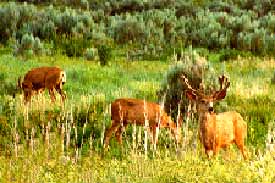
Mule Deer
The Mule Deer is a large deer of the western and central United States, so called because of its extremely large ears, which measure almost 25 cm (almost 10 in) in length. It attains a height of 107 cm (42 in) at the shoulder. It has a lithe, compact body and long, powerful legs suited for rugged woodland terrain and is an excellent swimmer. Its lower cheek teeth have crescent ridges of enamel, which enable it to grind a wide variety of vegetation. It's a cud chewer, and has a four-chambered stomach. In front of each eye is a facial gland containing a strongly scented substance used to mark its home range. The males open these glands wide when angry or excited. Antlers form only on males and are used to slash territorial markings on trees or bushes, to make threatening displays, and to combat other males. Usually the fighting is stylized and harmless, but occasionally large males lock antlers and die of exhaustion or starvation.
Deer forage on twigs, leaves, bark, and buds of bushes and saplings and on grasses and other plants, feeding most actively at twilight. The female gives birth once a year, usually to one or two fawns. Fawns are kept hidden in thickets, camouflaged by their dappled markings.
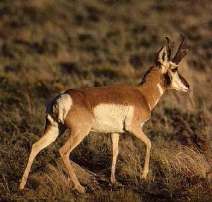
Pronghorn
The Pronghorn antelope is considered the fastest animal in North America, with a maximum recorded speed of 86.5 km/h (53.8 mph). Both sexes carry erect hollow horns that are shed yearly. Horns of the male have two prongs; the female's are short spikes. It is reddish brown with a dark brown mane, white underparts, two white bands on its neck, and a large white patch on its rump. When alarmed, it can make this hair stand straight out, producing a white flash. It inhabits open plains and semidesert, where it eats grass, forb, sagebrush, and cactus. It lives alone or in small groups in summer; some males join groups of females with offspring. There is never more than one adult male present in these groups. Other males form unisexual herds.
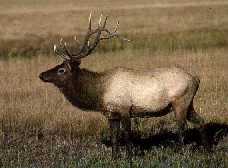
Elk
Wapiti, also American elk, is native to the northern part of the western hemisphere. It has dark brown fur on the head and neck, and creamy gray fur on the back and flanks. A full-grown stag stands up to 1.5 m (4.9 ft.) high at the shoulder, and weighs up to 340 kg (750 lb.). Antlers shed in March begin to grow again in late spring and are fully grown by fall, averaging more than 1.2 m (4 ft.) each in length. Stags live alone or in small groups most of the year, joining the herd only during the mating season, fighting over the right to females. The doe bears a single fawn. Wapiti graze and browse on grasses, twigs, and leaves and is now largely restricted to the mountainous areas of the western United States and Canada.

Bobcat
The bobcat is adapted to a warmer, drier climate than its relative to the north, the lynx. The bobcat has no need for the larger tufts of hair at the tips of the lynx's ears, which are believed to enhance hearing, since it has fewer problems seeing its prey among the sparser vegetation of a desert landscape. Not having to wade through deep snow, the bobcat has shorter legs than the lynx, and its foot pads lack fur. Its spotted coat helps it blend in with rocks and brush.

Red Fox
The red fox is 90 to 105 cm (36 to 42 in) long, not including the tail, weighs about 7 kg (about 15 lb.), and is distinguished by black ears and feet and a white tip on the tail. The coat is usually some shade of rusty-red or reddish-brown, sprinkled with light-tipped hairs. Its great alertness and keen senses of smell, hearing, and sight, enable it to live close to human habitation without being easily noticed. Farmland with woodlots and open fields provides it with good cover and abundant rodents, especially field mice. When red foxes have been eradicated from rural areas, populations of rodents have swelled.
On pairing, red foxes occupy a territory of 3 to 8 sq. km (1.5 to 3 sq. mi.). They mate in midwinter, and following a 49- to 56-day gestation period, the vixen bears two to eight cubs in a den that is frequently an enlarged groundhog hole. The cubs are born with their eyes closed and are attended in the den by both parents for about five weeks. By fall the young leave or are driven from the territory. Red foxes are believed to pair for life; their lifespan is about 12 years.
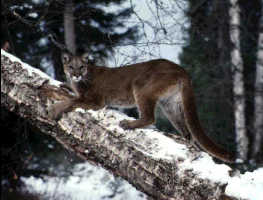
Puma
The puma, or mountain lion, Felis concolor, is the largest member of the cat family in North America. Pumas are solitary animals. Adults' hunting territories overlap less than those of other cats even though the migration pattern of their main prey, mule deer and elk, may reduce productive hunting grounds during the winter. Because of their limited contact, fighting between pumas rarely occurs.
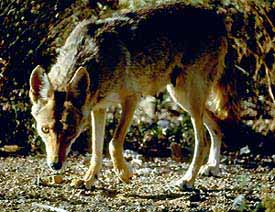
Coyote
The coyote is the most widespread relative of the wolf in North America. The native range of the coyote extends from Panama northward to the North Slope of Alaska and includes all states except Hawaii. Coyotes can survive in a variety of habitats and have successfully adapted to an urban existence in many parts of the United States and Mexico. Coyotes are most active at night, when they emit their characteristic sharp barks and prolonged howls; they are also active at dawn and dusk. Usually they hunt singly or in relays with others rather than in packs. They subsist on carrion, birds, large insects, and rodents, and can reach speeds of more than 60 km/h (more than 40 mph) when running down animals such as rabbits. Coyotes also prey on unprotected sheep and occasionally on weakened deer. Females come into heat once a year, from late January to early March; following a two-month gestation period, they bear 2 to 12 pups. The pups are tended by both parents, and by autumn they weigh 9 kg (20 lb.) and can fend for themselves. Coyotes probably mate for life.
 PAGE 3 PAGE 3



Top of Page
Copyright 1997 LaVone Luby -- All Rights Reserved
Site Design 1997 by Carol Tallman Jones -- All Rights Reserved
|